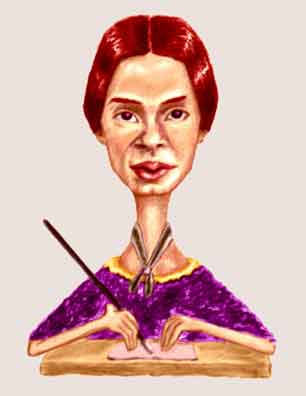Emily Dickinson
1830 - 1886

Emily Dickinson
You can sing her poems.
Emily was either the Belle of Amherst or the Nut of Amherst depending on your point of view. I mean, we learn she was a lady who shut herself up in her dad's house from the time she dropped out of college until she died at the age of 55. She spent her time writing poems that she wouldn't let anyone read, shunning any contact with the outside world so much she'd lower goodies down to kids in a basket rather than come to the door and hand them out. And she would only talk to her friends from behind a closed door.
Of course, nowadays historians (looking for new spins on old topics so they can publish rather than perish) can say she really wasn't that much of a recluse compared to Victorian era spinsters and that was really an affectation of her later years possibly because she didn't look her best due to a developing kidney disease, some of her poems were published in her lifetime and she included a lot of her poems in letters to her friends, and she would indeed go outside to work in her garden and play games with the neighborhood kids.
Alas, those of us who don't have the wisdom imparted by sitting on rosy red endowed chairs have to harbor some doubt that anyone really knows much about Emily. We do know she did well at college in what were then considered "masculine" subjects like chemistry, but she left after a year. No one really knows why she discontinued her education. But there were certainly some displeased matrons and teachers when she refused to troop down with the other sweet young things in chapel and "accept Christ". Emily, though, like the rest of her family were staunch abolitionists. Perhaps she simply felt that a doctrine doling out privilege or meting out punishment based on the people sharing common thoughts and beliefs was no better than a doctrine doling out privilege or meting out punishment based on people sharing common skin colors. But like much about Emily, no one really knows.
Popularity of Emily's poetry comes and goes, but right now it's doing pretty well. It's certainly accessible (to use a corny phrase) to the masses. After all, it has rhyme and meter both of which are verboten in modern literary magazines. Still you often read her poems and you wonder what the heck she was driving at.
A lot of her poetry was written in a rather ordinary, common meter - in fact, it's called "common meter" - and is the same scheme used in many traditional songs and ballads. So it's often possible to sing Emily's poems to the tune of popular songs. For instance, sing "The Ballad of Gilligan's Island"
Just sit right back and you'll hear a tale
A tale of a fateful trip
That started from this tropic port
Aboard this tiny ship.
Then try the tune on Emily's peaceful but rather eerie poem "Because I Could Not Stop for Death":
Because I could not stop for Death
He kindly stopped for me
The carriage held but just ourselves
And Immortality.
Now you'll never be able to read Emily's poems without thinking of "Gilligan's Island".
Sorry about that, Emily, little buddy.